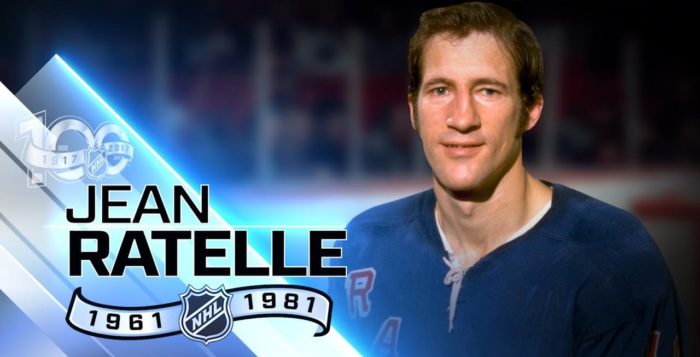This Day in Hockey History – November 21, 1971 – Rangers Strike Gold
The NHL “is going to have to start billing games involving an expansion club as exhibitions,” crowed the New York Daily News after the New York Rangers trounced the California Golden Seals 12-1 on November 21, 1971. Part of that blow-out included record-breaking scoring in one period. The biggest individual scorer of the night was center Jean Ratelle with four goals and an assist.
Madison Square Garden hosted the game, so 17,250 local fans had the treat of watching the Rangers score and continue scoring. Ratelle started the night off right with the opening goal at 4:11. Almost 11 minutes later, he assisted linemate Vic Hadfield with the next. In the middle period, Ratelle followed Ted Irvine with another goal.
The Rangers led 4-0 when the Golden Seals finally had a shot. At 17:52, Norm Ferguson “hit something in the net and ricocheted out. Goal judge Lee Stark, because he wasn’t sure the puck had gone in, rightfully refrained from lighting his lamp.” The Daily News continued, “The Seals beefed to Skov and, after consulting linesmen John D’Amico and Ray Scapanello, he sustained the visitors’ plea. The Rangers then launched an appeal, but Skov wouldn’t buy it. The close-circuit TV re-run showed the puck did go in, a happening that cost Ranger goalie Gilles Villemure a shutout.”
After the intermission, New York made that goal nothing but a distant memory. Again, Ratelle took control. He scored just 41 seconds into the third period and again at 3:40, after Irvine’s second. In less than four minutes, the Rangers had tallied another three goals. With that, Ratelle had the “most productive game of his career.” Hadfield had assisted on two of his goals, and linemate Rod Gilbert had assisted on three. Combined, the GAG Line had 11 points, the most in one game by any Rangers line. With 94 points in 19 games, they were outpacing the record-breaking scoring Phil Esposito’s line set for the Boston Bruins the previous season.
While that was the end of Ratelle’s five points in five shots on net, his team was far from finished. Gene Carr found the back of the net at 6:44 and 12:37. Between them, at 11:03, rookie Pierre Jarry tallied his first NHL goal. At the point of tears, California’s 20-year-old rookie goalie, Gilles Meloche, was finally pulled. His replacement, 26-year-old Lyle Carter, had only eight seconds before Jarry scored his second NHL goal. Jarry’s back-to-back goals set a new speed record for the Rangers, beating the one Phil Goyette had set in 1967. Bill Fairbairn capped off the game with just over half a minute remaining.
The eight goals scored in the third period made for a total of 23 points, a new NHL record for most points in one period. Previously, the Detroit Red Wings had set the record at 22 points back on January 23, 1944, and the Boston Bruins had matched that on March 16, 1969. The record still stands but has been matched by the Buffalo Sabres on two occasions, December 21, 1975 and March 19, 1981.
The remainder of the 1971-72 season mostly went well for Ratelle and the GAG Line. Not for nothing were they called the Goal-A-Game Line. As Ratelle said at the time, “We’re like perfectly meshed gears. We have a pretty good idea of where each guy is going to be on any given play.”
Ratelle led the scoring through February 20, 1972, when he became the first Ranger to score 100 points in a season. On March 1, when playing the Golden Seals again, Ratelle broke his ankle and was not able to rejoin the team until the Stanley Cup Final. Fortunately, Hadfield kept the Rangers going by becoming their first player to have 50 goals in a season. In the NHL scoring rankings that season, Ratelle finished third, Hadfield fourth, and Gilbert fifth as the GAG Line became the best in the league with 312 points total. Even though his injury prevented Ratelle from winning the Art Ross Trophy or the Hart Memorial Trophy, he did receive the Lester B. Pearson Award (now the Ted Lindsay Award).
Additional Sources:
- https://www.nhl.com/gamecenter/cgs-vs-nyr/1971/11/21/1971020136#game=1971020136,game_state=final
- Red Foley, “Rangers Slaughter Seals, 12-1; Ratelle: 4 Goals,” New York Daily News, 22 Nov. 1971, p. 77.
- https://records.nhl.com/records/team-records/player-points/most-points-one-team-one-period
- https://thepinkpuck.com/2019/07/01/this-day-in-hockey-history-july-1-1941-g-is-for-gag-line/















[…] in just 27 shots (for a .724 save percentage). This was the same goalie who gave up 12 goals in the Rangers-Golden Seals game back in 1971. “Did you guys come in to ask me real questions or just to laugh at me,” Meloche asked the […]